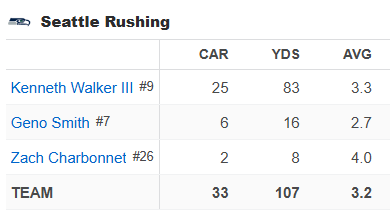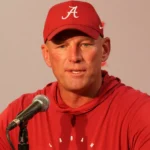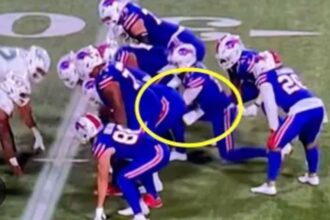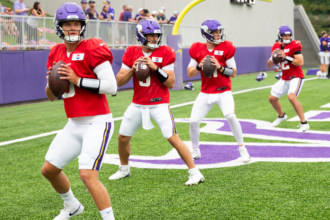The Seattle Seahawks only needed one yard to extend their drive and move closer to an impressive comeback against the Los Angeles Rams. But, once again, they came up short. With a 4-5 record, the Seahawks are last in the NFC West, the only team in the division with a losing record. Their record might be 5-4 if Geno Smith hadn’t thrown a critical pick-six and an interception near the end zone. Or if their offensive line, entrusted to gain just a single yard with two second-round running backs on the roster, had held strong.
This particular play highlights what’s become John Schneider’s most significant weakness as general manager: Seattle’s recurring issues with its offensive line. Though Smith is mobile and skilled at avoiding pressure, he isn’t the type of young, ultra-athletic quarterback who can routinely dodge the pass rush and make plays on the run. Despite a solid running game, the Seahawks couldn’t produce a run of more than 10 yards for the third time in four weeks.
No matter who’s been in charge, the Seahawks have consistently struggled to build even a moderately effective offensive line over Schneider’s 15-year tenure as GM. But unlike the past 14 seasons, this year, the team is Schneider’s responsibility alone, with no shared decision-making with Pete Carroll. There’s no Pete Carroll to lean on or blame.
Geno Smith has never played behind a pass-blocking line ranked higher than 20th in PFF’s metrics, marking 13 seasons without his offensive line breaking into the league’s upper half. The 2024 Seahawks’ offensive line has proven especially ineffective because, unlike previous lines, they’re also below average at run blocking. This begs the question: what exactly is their strength?
The six linemen Seattle fielded on Sunday were largely assembled by GM John Schneider. Key players like Laken Tomlinson, Connor Williams, and George Fant were free-agent signings under his direction. Michael Jerrell was a draft pick, though he arguably shouldn’t have been playing except for injuries. Christian Haynes, another draft choice, was benched in favor of Anthony Bradford, who turned in one of his poorest performances as a Seahawk.
:no_upscale()/cdn.vox-cdn.com/uploads/chorus_asset/file/25714217/C3HaMzaXgAEeudZ.jpg)
The Seahawks may face another offensive line rebuild in 2025, as Tomlinson was brought in on a short-term contract, Williams has struggled significantly the past two games, and Abe Lucas’s future is uncertain due to injury. Bradford appears to have regressed since his rookie season, and the team may end up needing to replace up to four starters—continuing the cycle of mediocrity that has plagued Seattle’s line.
Schneider himself remarked in March that guards tend to be “overdrafted” and “overpaid,” and it seems his own choices might support that view—at least one overpaid guard is evident.
John Schneider hasn’t completely overlooked the offensive line throughout his tenure. Early on, he and Pete Carroll prioritized it, with their first draft pick together being Russell Okung, followed by James Carpenter in the first round the next year. They extended Max Unger’s contract after his Pro Bowl season in 2012, and in 2013, the Seahawks actually had the most expensive offensive line in the league. Unfortunately, that year saw many injuries, forcing backups like Paul McQuistan and Michael Bowie into significant roles, which didn’t yield the results hoped for.
Justin Britt is the only Seahawks lineman drafted by Schneider to ever receive a contract extension. The rest either played through their rookie deals or didn’t even make it that far, like Ethan Pocic, who got a one-year re-sign, and J.R. Sweezy, who returned briefly after a stint in Tampa Bay. Although Damien Lewis has shown promise, he was allowed to move on and is now playing well with Carolina.
The Seahawks have invested heavily in drafting offensive linemen, with Charles Cross showing potential and Abe Lucas’s struggles largely due to injury. However, a concerning pattern emerges when looking at draft picks like John Moffitt, Rees Odhiambo, Jamarco Jones, Germain Ifedi, and Phil Haynes, who mostly topped out as average. This hints at an ongoing scouting and development issue that seems unique to Seattle.
:no_upscale()/cdn.vox-cdn.com/uploads/chorus_asset/file/25714220/Legion_of_Boom_DOMINATES_in_MetLife_Seahawks_vs_Giants_2013_Week_15_YouTube_11_03_2024_09_02_PM.png)
Schneider’s biggest misstep with the offensive line might be his approach to free agency. Seattle has rarely gone all-in for a top free agent. The Duane Brown trade in 2017 stands out as one big move, which was mostly reactive after George Fant’s ACL tear left them scrambling at left tackle. Seattle’s most significant offseason trade was giving up a fourth-round pick for Gabe Jackson, a response to Russell Wilson’s public frustrations with protection issues. Jackson was extended but didn’t complete his contract and isn’t currently on an NFL roster.
The free agent signings, though, have often been underwhelming. From Robert Gallery in 2011, who lasted only a year of his three-year contract, to more recent short-term additions like Laken Tomlinson, Luke Joeckel, J’Marcus Webb, and B.J. Finney, the trend has been largely low-cost and low-impact deals. Even D.J. Fluker, one of the few to receive an extension, was cut after his second season. Altogether, these contracts add up to less than $75 million.
In contrast, Seattle has never hesitated to spend big on its defensive line, with high picks like Jarran Reed, Malik McDowell, and Byron Murphy II, along with trades for Leonard Williams and others. But similar investment hasn’t extended to the offensive line. There was a time when the Seahawks could mask offensive line issues with an elite dual-threat quarterback and one of the best power backs in the game, but that advantage is no longer there.
During the Seahawks’ prime, they had the league’s best defense, allowing them to manage through periods when the offense struggled with sacks, penalties, and stalled drives. However, Seattle no longer has the elite quarterback or roster depth to treat the offensive line as a replaceable, low-cost component.
Seattle has had options to improve, like signing a quality center such as Tyler Biadasz, who’s been pivotal in Washington’s offensive line success for a reasonable $10 million per year. It’s possible to invest in solid players without overspending, and decisions like this could be essential to restoring balance on the Seahawks’ offense.
While Pete Carroll has been called out for his struggles in reconstructing the defense, the current state of the offensive line might be Schneider’s greatest failure. He has undeniably been successful—overseeing many winning seasons and a Super Bowl victory—but a good reputation doesn’t last forever without ongoing results. Assuming Schneider remains GM into 2025, he’ll need to address these long-standing issues to avoid a disappointing end to the Carroll-Schneider era. Otherwise, Seattle might soon be searching for new leadership, marking a stark contrast to the brilliance of their peak seasons.






